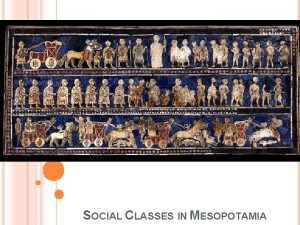Mesopotamia Social Classes There were four main classes





- Slides: 5

Mesopotamia Social Classes There were four main classes of people in ancient Sumer - the priests, the upper class, the lower class, and the slaves.

The Priests The priests were powerful. They were in charge of making sure everyone behaved in a way that would make the gods happy. They were the doctors of the time. If you were sick, you called for a priest. It was easy to tell who were the priests. The priests shaved their heads. There is a written record of two priests, by the bed of a sick boy, dressed to look like fish to better speak with the water god. (We do not know why the priests wanted to talk to the water god. )

The Upper Class Men and women wore jewelry, especially rings. Men wore skirts and had long hair, curly moustaches, and long beards. Women wore dresses, off one shoulder. They had long hair, which they braided or wore up in fancy arrangements. Everyone wore cloaks made from sheep wool to keep warm in winter.

The Lower Class In ancient Sumer, people were paid for their work. If they ran a shop or worked in the fields, they were paid for their goods or labor. Stealing was a serious crime and punishment was severe. Everybody paid, even the king. Although the lower class did not have the luxury lifestyle of the rich, they were comfortable. They worked very hard, but they had homes. They wore jewelry, although perhaps it was not made of gold. They followed the clothing fashions of the time as much as possible. There was no law that said they could not move up the social scale, or more likely, have their children move up the social scale by becoming a scribe, or a priest or priestess.

The Slaves When the Sumerians conquered another town, they brought prisoners back with them to act as slaves. Slaves worked for the king, the temple and the wealthy. Slaves were bought and sold. Records have been found recording the amount paid for a slave. Typically, a slave bought at auction cost less than a donkey but more than a cow.








